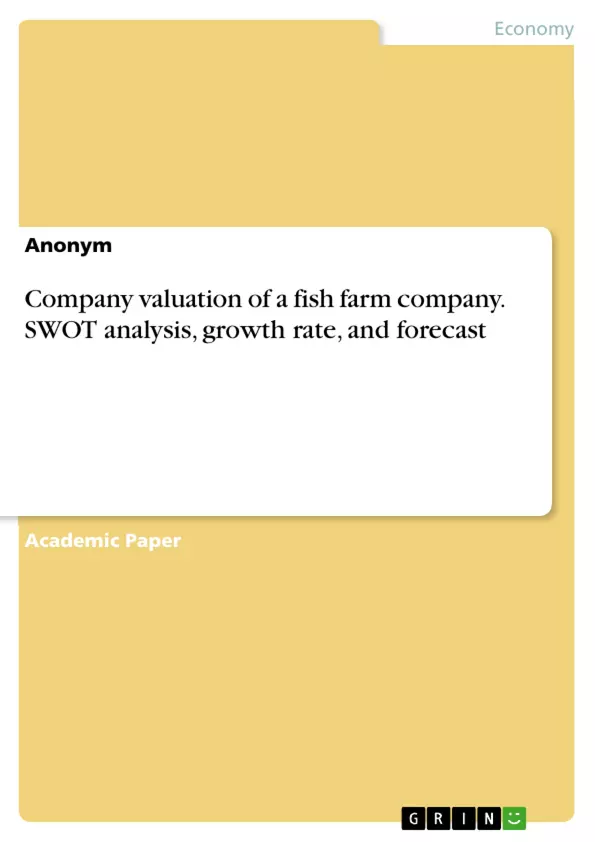This paper is about the company valuation with salmon in Norway.
Norway is the world leading supplier of Atlantic salmon. The country supplies approximately twice as much as Chile, which is the second largest supplier. From 2018 to 2019, Norwegian export increased by 7% due to the stable price of salmon. Europe, as the most important export destination accounted for 74% of the export in 2019. Poland, Denmark, and Sweden were the most significant single markets along the 56 countries SalMar exports to. In addition, Asia is another important market for SalMar. The imports in the region grew by 29% between 2018 and 2019.
Inhaltsverzeichnis (Table of Contents)
- Company Overview
- Market conditions
- Competition & Growth Rates
- SWOT
- Correcting accounting earnings
- Weighted average cost of capital
- Risk free rate (rf)
- Capital-Structure
- Beta
- Unlevered Beta
- Levered Beta
- Market Risk Premium
- Country Risk Premium
- Cost of Equity
- Cost of Debt (rd)
- Interest Coverage Ratio
- Default Spread
- WACC
- Free cash flow to the firm (FCFF)
- Forecasting free cash flow
- Growth Rate
- Reinvestment Rate
- Return on Capital (ROC)
- Fundamental Growth Rate
- Discounted cash flow
- Relative Valuation
- P/E
- EV/EBITDA
- Conclusion
Zielsetzung und Themenschwerpunkte (Objectives and Key Themes)
This work aims to perform a comprehensive valuation of SalMar ASA, a Norwegian fish farm company, using a combination of discounted cash flow (DCF) and relative valuation techniques. The analysis takes into account the company's financial performance, market conditions, competition, and growth prospects.
- Company Overview and Key Business Areas
- Market Conditions and Growth Opportunities in the Salmon Farming Industry
- Competitive Analysis and Key Industry Players
- Financial Statement Analysis and Adjustments for Valuation Purposes
- Valuation Techniques: Discounted Cash Flow and Relative Valuation
Zusammenfassung der Kapitel (Chapter Summaries)
- Company Overview: This chapter provides an overview of SalMar ASA, its history, main business areas, and strategic objectives. It highlights the company's position as a leading producer of farmed salmon in the world and its operations in Norway, Iceland, and Scotland.
- Market conditions: This chapter examines the market conditions for Atlantic salmon, focusing on Norway's role as the world's leading supplier. It analyzes the global supply chain, key export markets, and the growth prospects for the industry. The chapter also discusses the challenges and opportunities related to the expansion of salmon farming.
- Competition & Growth Rates: This chapter analyzes the competitive landscape within the salmon farming industry, highlighting the key players and their market shares. It examines the growth rates of different segments of the industry and explores the factors that drive revenue growth.
- Correcting accounting earnings: This chapter delves into the adjustment of SalMar's financial statements for valuation purposes. It explains the rationale for adjusting operating leases and R&D expenses, and provides examples of how these adjustments affect the balance sheet and income statement.
Schlüsselwörter (Keywords)
The primary focus of this text is on company valuation and analysis of the salmon farming industry. Key terms include: SalMar ASA, Atlantic salmon, aquaculture, market conditions, competition, SWOT analysis, financial statement analysis, operating leases, discounted cash flow (DCF), relative valuation, P/E ratio, EV/EBITDA ratio, and cost leadership strategy.
- Quote paper
- Anonym (Author), 2020, Company valuation of a fish farm company. SWOT analysis, growth rate, and forecast, Munich, GRIN Verlag, https://www.grin.com/document/1030204



